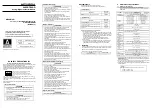
I
NSTALLATION
G
UIDE
38
I
NSTALLATION
A
CTIVE
/R
EACTIVE
P
OWER
C
ONTROL
A
ND
F
AULT
R
IDE
T
HROUGH
5.10.2.3. Fixed Reactive Power
Once user enables this method, inverter will deliver reactive power (ie. Q) according to the
fixed reactive power setting. The setting range is from Cap 60% to Ind 60%.
5.10.2.4. Reactive Power/Voltage Characteristic Q(U)
After selecting “Q(U) control”, User can set Q vs. Grid voltage operation curves as below.
Figure 5-25. Q(U) characteristic
5.10.3. Fault Ride Through (FRT)
According to BDEW:
2.5.1.2 Dynamic network support
Dynamic network support means voltage control in the event of voltage drops within the high
and extra-high voltage network with a view to avoiding unintentional disconnections of large
feed-in power, and thus network collapse. In the light of the strong increase in the number of
generating plants to be connected to the medium-voltage network, the integration of these
plants into the dynamic network support scheme is becoming ever more important.
Consequently, these generating plants must generally participate in dynamic network support
even if this is not required by the network operator at the time of the plant’s connection to the
network. That means that generating plants must be able in technical terms
not to disconnect from the network in the event of network faults,
to support the network voltage during a network fault by feeding a reactive current into
the network,
not to extract from the medium-voltage network after fault clearance more inductive
reactive power than prior to the occurrence of the fault.
These requirements apply to all types of short circuits (i.e. to single-phase, two-phase and
three-phase short circuits).
Just like in the Transmission Code 2007 7, a distinction is made in these guidelines between
type-1 and type-2 generating plants with regard to their behaviour in the event of network
disturbances. A type-1 generating unit exists if a synchronous generator is directly (only
through the generator transformer) connected to the network. All other plants are type-2
generating units.
The following conditions shall apply to type-2 generating plants, taking the Transmission
Code 2007, Section 3.3.13.5, into account:
Generating units must not disconnect from the network in the event of voltage drops to 0
% Uc of a duration of ≤ 150 ms.
Summary of Contents for PhotoVoltaic RPI-C500
Page 1: ...PhotoVoltaic Inverter RPI C500 PV Inverter ...
Page 88: ...INSTALLATION GUIDE 82 ...
Page 89: ...光伏逆变器 RPI C500 光伏逆变器 ...
Page 100: ...安装手册 5 产品外观 外部三角视图 3 2 2 外部三角视图 图 3 2 外部后视图 进气孔 ...
Page 114: ...安装手册 20 安装说明 DC 端连接 图 5 4 DC 端连接端尺寸图 ...
Page 116: ...安装手册 22 安装说明 AC 端连接 5 3 AC 端连接 1 如图 5 6 所示将连接到 AC 端的电缆穿过底板 图 5 6 AC 端配线 ...
Page 119: ...安装手册 25 安装说明 AC 端连接 图 5 9 AC 端连接端尺寸图 ...
Page 156: ...安装手册 62 维修保养 更换风扇模块 7 维修保养 7 1 更换风扇模块 1 按拉且扭转把手 之后打开后门 图 7 1 按拉扭转把手 ...
Page 158: ...安装手册 64 维修保养 更换风扇模块 4 松开锁附在上风扇与机壳上的螺丝 然后将上风扇移除 图 7 4 松开上风扇的螺丝 ...
Page 160: ...安装手册 66 维修保养 更换进气口滤网 3 松开锁附在滤网上的螺丝 图 7 7 松开滤网的螺丝 4 取出滤网 图 7 8 取出滤网 ...
Page 162: ...安装手册 68 维修保养 清理排气孔滤网 4 直接取出挡板和排气孔滤网 图 7 11 取出排气孔滤网 ...
Page 165: ...安装手册 71 维修保养 更换 SURGE PROTECTION DEVICE 4 退出已损坏的 SPD 并更换新的 Figure 7 15 退出已损坏的 SPD ...
Page 176: ...Version 01180521 5013209808 ...
















































